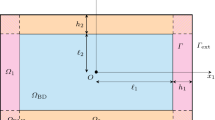Abstract
This paper discusses a Gauss-Newton full-waveform inversion procedure for material profile reconstruction in semi-infinite solid media. Given surficial measurements of the solid’s response to interrogating waves, the procedure seeks to find an unknown wave velocity profile within a computational domain truncated by Perfectly-Matched-Layer (PML) wave-absorbing boundaries. To this end, the inversion procedure minimizes a Lagrangian functional composed of a cost functional augmented by PML-endowed wave equations via Lagrange multipliers. Enforcing the stationarity of the Lagrangian leads to KKT (Karush-Kuhn-Tucker) conditions comprising time-dependent state, adjoint, and time-invariant control problems. The material parameter is updated by iteratively solving the KKT conditions in the reduced space of the control variable. The update of the control variable is determined by a Gauss-Newton-Krylov optimization algorithms. Super-linear convergence behavior of the Gauss-Newton inversion has been observed in one-dimensional implementations. Regularization and frequency-continuation schemes were used to relieve the ill-posedness of the inverse problem.
Similar content being viewed by others
References
Akcelik, V. (2002). Multiscale Newton-Krylov methods for inverse acoustic wave propagation, PhD Thesis, Carnegie Mellon University, Pittsburgh, PA, USA.
Akcelik, V., Biros, G., and Ghattas, O. (2002). “Parallel multiscale Gauss-Newton-Krylov methods for inverse wave propagation.” Proceedings of the 2002 ACM/IEEE conference on Supercomputing, pp. 1–15.
Born, M. and Wolf, E. (1980). Principles of optics, 6th Edition, Pergamon Press, New York, N.Y.
Brezzi, F. and Fortin, M. (1991). Mixed and hybrid finite element methods, Springer Verlag, Berlin, Germany.
Chew, W. (1990). Waves and Fields in inhomogeneous media, Van Nostrand Reinhold, New York, N.Y.
Chew, W. and Liu, Q. (1996). “Perfectly matched layers for elastodynamics: A new absorbing boundary condition.” Journal of Computational Acoustics, Vol. 4, No. 4, pp. 341–359.
Collino, F. and Tsogka, C. (2001). “Application of the perfectly matched absorbing layer model to the linear elastodynamic problem in anisotropic hetetogeneous media.” Geophysics, Vol. 66, No. 1, pp. 294–307.
Colton, D. and Monk, P. (1988). “The inverse scattering problem for time harmonic acoustic waves in an inhomogeneous medium.” Quarterly Journal of Mechanics and Applied Mathematics, Vol. 41, pp. 97–125.
Devaney, A. J. (1982). “A filtered back-propagation algorithm for diffraction tomography.” Ultrasonic Imaging, Vol. 4, pp. 336–360.
Eisentat, S. and Walker, H. (1996). “Choosing the forcing terms in an inexact Newton method.” SIAM Journal on Scientific Computing, Vol. 17, pp. 16–32.
Epanomeritakis, I., Akcelik, V., Ghattas, O., and Bielak, J. (2008). “A Newton-CG method for large-scale three-dimensional elastic fullwaveform seismic inversion.” Inverse Problems, Vol. 24, No. 3.
Gao, F., Levander, A., Pratt, R. G., Zelt, C. A., and Fradelizio, G. L. (2007). “Waveform tomography at a groundwater contamination site: surface reflection data.” Geophysics, Vol. 72, pp. G45–G55.
Habashy, T. M. and Mittra, R. (1987). “On some inverse methods in electromagnetics.” Journal of Electromagnetic Waves and Applications, Vol. 1, No. 1, pp. 25–58.
Kang, J. W. and Kallivokas, L. (2010). “The inverse medium problem in 1D PML-truncated heterogeneous semi-infinite domains.” Inverse Problems in Science and Engineering, Vol. 18, No. 6, pp. 759–786.
Kang, J. W. and Kallivokas, L. F. (2011). “The inverse medium problem in heterogeneous PML-truncated domains using scalar probing waves.” Computer Methods in Applied Mechanics and Engineering, Vol. 200, Issues 1–4, pp. 265–283.
Lin, F. C. and Fiddy, M. A. (1990). “Image estimation from scattered field data.” International Journal of Imaging Systems and Technology, Vol. 2, No. 2, pp. 76–95.
Nocedal, J. and Wright, S. (1999). Numerical optimization, Springer Verlag, New York, N. Y.
Operto, S., Ravaut, C., Improta, L., Virieux, J., Herrero, A., and Dell’Aversana, P. (2004). “Quantitative imaging of complex structures from dense wide-aperture seismic data by multiscale traveltime and waveform inversions: a case study.” Geophysical Prospecting, Vol. 52, No. 6, pp. 625–651.
Pratt, R. G. and Shipp, R. M. (1999). “Seismic waveform inversion in the frequency domain, part 2: Fault delineation in sediments using crosshole data.” Geophysics, Vol. 64, No. 3, pp. 902–914.
Rudin, L., Osher, S., and Fatemi, E. (1992). “Nonlinear total variation based noise removal algorithms.” Physica D, Vol. 60, pp. 259–268.
Saad, Y. (2000). Iterative methods for sparse linear systems, 2nd Edition, SIAM.
Tikhonov, A. (1963). “Solution of incorrectly formulated problems and the regularization method.” Soviet Math. Doklady, Vol. 4, pp. 1035–1038.
Author information
Authors and Affiliations
Corresponding author
Rights and permissions
About this article
Cite this article
Pakravan, A., Kang, J.W. A Gauss-Newton full-waveform inversion for material profile reconstruction in 1D PML-truncated solid media. KSCE J Civ Eng 18, 1792–1804 (2014). https://doi.org/10.1007/s12205-014-0087-0
Received:
Accepted:
Published:
Issue Date:
DOI: https://doi.org/10.1007/s12205-014-0087-0




